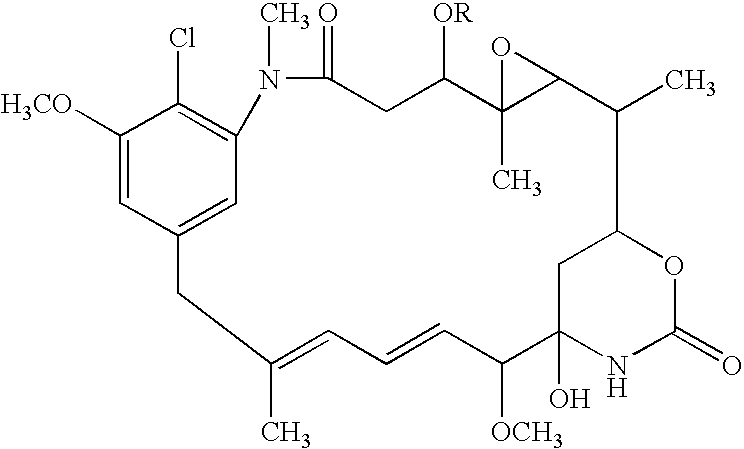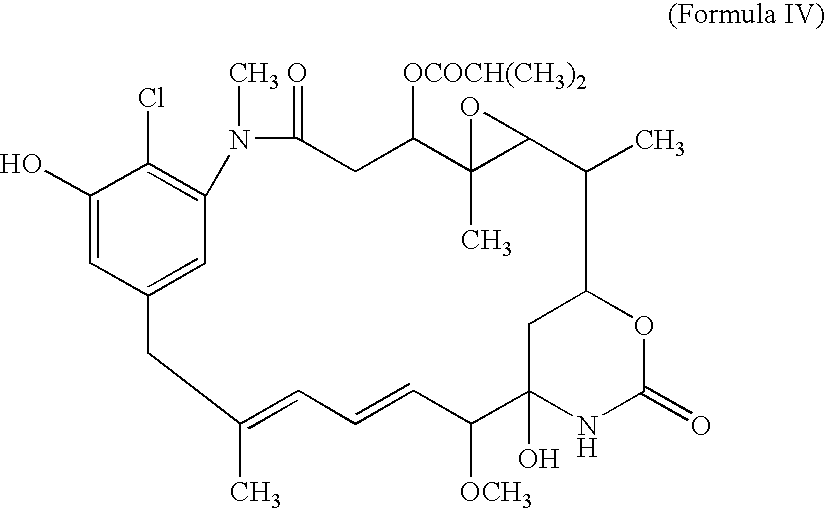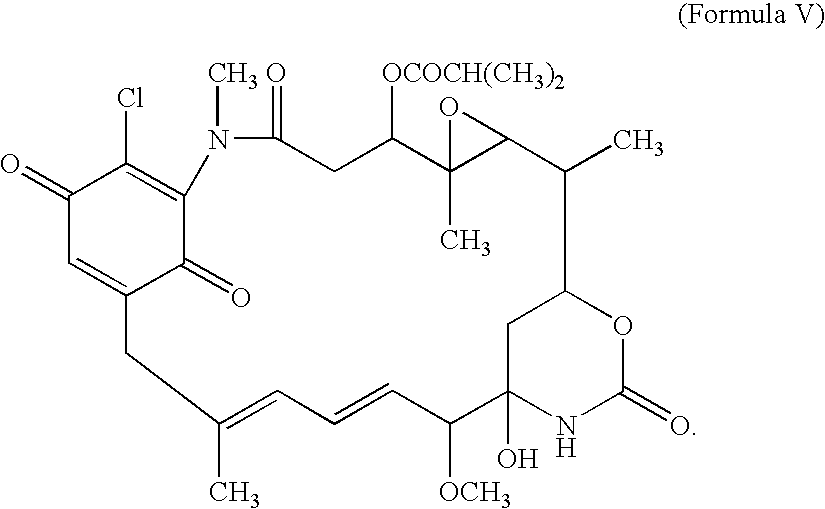Maytansinoid analogs as antitumor agents
an antitumor agent and maytansine technology, applied in the field of maytansine, can solve the problems of disappointing maytansine and no significant clinical benefit from its administration to human cancer patients, and achieve the effects of improving clinical activity, reducing systemic toxicity, and improving pharmacokinetic profil
- Summary
- Abstract
- Description
- Claims
- Application Information
AI Technical Summary
Benefits of technology
Problems solved by technology
Method used
Image
Examples
example 1
Non-Hydrolyzable Ester Analogs of AP3 and their Antitumor Activity
[0043]Ansamitocin P-3 (AP3) is reduced with Li(OMe)3AlH to produce maytansinol. Chloromethylketone derivatives are prepared from isobutyric acid, hexadecanoic acid, and phenylglycine, respectively, by conversion to acid chloride (which may require N-protection in the case of phenylglycine), reaction with diazomethane, and reaction of the diazoketone with HCl.
[0044]Maytansinol is reacted with the three chloroketones to produce the analogs of Formulas I, II and III:
[0045]
wherein R is chosen from:[0046]Formula I: CH2COCH(CH3)2,[0047]Formula II: CH2CO(CH2)16CH3, and[0048]Formula III: CH2COCH(NH2)Ph.
[0049]The three analogs are tested for cytotoxicity in appropriate cancer cell lines and in a tubulin binding assay.
example 2
Production of Maytansinoid-Geldanamycin Hybrid-Type Molecules
[0050]In this Example, hybrid molecules are constructed that combine the mode of action of maytansinoids, i.e., inhibition of tubulin polymerization, with that of geldanamycin, i.e., inhibits heat shock protein 90 (HSP-90). In particular, the hybrid molecules retain the cyclic carbinolamide structure of the ansamitocins.
[0051]Biotransformation of AP3 is carried out using Bacillus megaterium IFO 12108 to produce 20-O-demethyl-AP3 (this procedure is known in the art and has been described in detail elsewhere):
[0052]
[0053]The compound of Formula IV is then oxidized to yield the quinone:
[0054]
[0055]The quinone (Formula V) is then converted into the 17-DMAG analog (Formula VI) by addition of 2-N,N-dimethylaminoethylamine.
[0056]
[0057]The compounds of Formulas IV, V, and VI are then tested for tubulin binding and for HSP-90 binding, as well as for cytotoxicity.
example 3
Preparation and Testing of Additional Analogs
[0058]This Example describes the preparation and testing of additional analogs.
[0059]A mutant of Actinosynnema pretiosum is engineered in which genes asm7, 10, 11, and 12 have been deleted. The genotype is then confirmed.
[0060]The mutant is fermented and cultures are assayed for production of deschloro-20-O-demethyl-N-demethyl-desepoxy-AP3:
[0061]
[0062]The compound of Formula VlI is oxidized to the quinone of Formula VIII:
[0063]
[0064]The quinone (Formula VIII) is derivatized to yield the 17-DMAG analog:
[0065]
[0066]Compounds VlI, VIII, and IX are tested for general cytotoxicity, for HSP-90 binding, and for tubulin binding.
PUM
| Property | Measurement | Unit |
|---|---|---|
| structure | aaaaa | aaaaa |
| Ph | aaaaa | aaaaa |
| structures | aaaaa | aaaaa |
Abstract
Description
Claims
Application Information
 Login to View More
Login to View More - R&D
- Intellectual Property
- Life Sciences
- Materials
- Tech Scout
- Unparalleled Data Quality
- Higher Quality Content
- 60% Fewer Hallucinations
Browse by: Latest US Patents, China's latest patents, Technical Efficacy Thesaurus, Application Domain, Technology Topic, Popular Technical Reports.
© 2025 PatSnap. All rights reserved.Legal|Privacy policy|Modern Slavery Act Transparency Statement|Sitemap|About US| Contact US: help@patsnap.com



